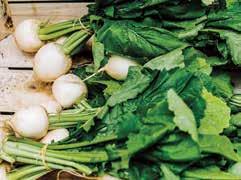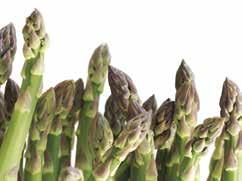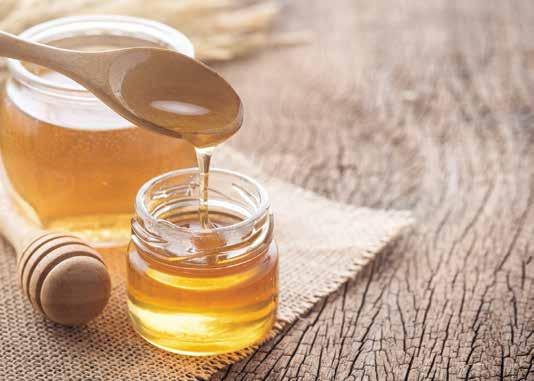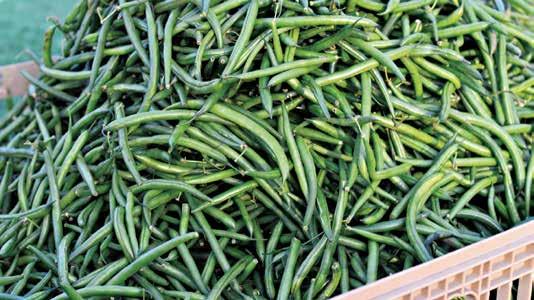
10 minute read
SEASONAL SENSORY
Photo by PheelingsMedia for Adobe Stock Seasonal Sensory
Health Tips
Advertisement
for a Joyful Summer
by Polly Liontis
Chinese medicine philosophy has a concept called “living according to our nature”, which encourages us to observe the intelligence in the natural world (Mother Earth, Father Sky, the five seasons in nature) and live accordingly. We can derive clues for nourishing our own health by following the rhythms of the Earth and the daily cycle of energy.
A Zen proverb states, “When you’re hungry, eat, when you’re tired, sleep,” which is another way of saying, “Listen to your body, your emotions, your own inner wisdom.” During this end-of-the-summer phase, the Earth comes to its fullest expression. The crops are fully ripe and ready to be harvested, so it is a time of deep nourishment from the gifts of the Earth’s harvest; a time to replenish and savor the bounty.
One of our most powerful actions to improve our immune system and overall health is to adopt a daily practice of gratitude. Savor the gifts of the moment. Even in times of great adversity, we can still affirm, “I’m alive, I’m breathing, the Earth is nourishing me with food, the sky is nourishing me with sunlight.” Here are a few more tips for excellent self-care and real nourishment as we move through the fullness of summer:
1Use a neti pot daily. A neti pot is a small pot in which you make a saline solution to rinse your nasal passages. Especially with summer frequently being a time of bad air quality and heightened allergies, rinsing the nasal passages can help you breathe more easily and clearly. Visit HimalayanInstitute.org to order a neti pot and also Ayurvedic nose oil to lubricate dry nasal passages.
2Allow yourself to enjoy some sunshine,especially first thing in the morning, as it helps to regulate your circadian rhythms, which promote good quality sleep. 3 Get outdoorsevery chance you can with the great weather for a brisk walk, time in a beautiful park, a visit to the botanic gardens or a stroll by the lake. The fresh air boosts your mood, as well as your body.
4Eating locally and seasonally is healthy and a visit to your local farmers’ market is just the thing. Summer brings us a bounty of fresh fruits and vegetables, so this is a perfect time to ramp up your plant-based diet. The sweetness of the fresh fruit is a sensuous delight.
5 Fill a pitcher of water and add slices of cucumber, lemon, or lime for a refreshing way to hydrate. Hydration is crucial in the heat of summer.
6Getting more exercise outdoors in the summer can give you momentum to keep it going indoors during the winter.
7Reach out to connect with others—relational health is paramount to our overall health and well-being. A quick phone call, text, video call or short, handwritten note will let someone know you’re thinking about them.
8Give yourself permission to smile—we can choose to laugh, and a great way to do that is to tune in to a comedy show that helps us to laugh at ourselves. Lastly, give yourself the gift of a slower pace with time to relax, daydream, enjoy your loved ones, have a backyard picnic and lean back and smile.
Polly Liontis completed the teacher training program at the Himalayan Institute, led by Pandit Rajmani Tigunait at the Glenview, Illinois, ashram in 1999. She was initiated into the lineage of Swami Rama of the Himalayas by Pandit Rolf Sovik with her own personal mantra in 1999.
Zen Shiatsu is located at 825 Chicago Ave., in Evanston. For more information, call 847-864-1130 or visit ZenShiatsuChicago.org.
See ad on the back cover, in the Community Resource Guide and in the online Business Directory at NAChicago.com.
No-Waste Garden Edibles Ways to Maximize Your Garden’s Bounty
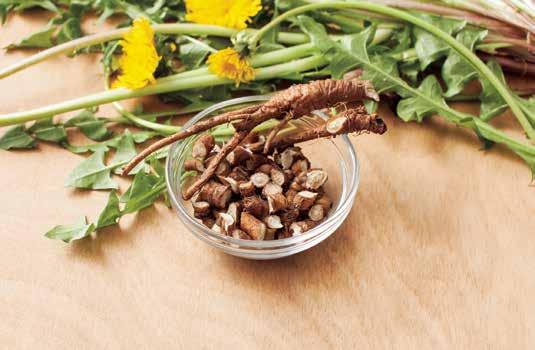
by April Thompson
Most gardens are loaded with delicious, nutritious food that goes uneaten and overlooked, from edible greens like sweet potato leaves to flavorful flowers like tulips, marigolds and wisteria. Getting better acquainted with the edible parts of common backyard plants opens up a world of culinary possibilities. With continued concerns around potential exposure to COVID-19, maximizing a garden’s bounty while minimizing trips to the grocery store is an added benefit.
“Food foraged from your backyard is fresher, tastier and cheaper than storebought food,” says Ellen Zachos, the Santa Fe author of Backyard Foraging: 65 Familiar Plants You Didn’t Know You Could Eat. “There is also the novelty factor. People don’t expect to be served a BBQ sauce made from crabapples or a curd made with flowering quince fruit. You simply can’t buy those flavors.”
Many plants and trees commonly thought of as being ornamental have edible parts. Hostas are a common one that Zachos loves to nibble on as much as the deer do. “You can harvest at a couple stages: First, when spears are poking up and the leaves have not unfurled. A little later in the season, you can blanch them and put in a stir fry or quiche, or roast them as you would asparagus,” explains Zachos.
Roses are another multipurpose ornamental, with organically grown rose petals making aromatic additions to sweet or spicy treats. Leaving the roses to decay after the first frost rather than dead-heading them yields rose hips rich in vitamin C for teas and jams.
Tip-to-Root Eating
Several common vegetables are edible from leaf to root, including broccoli, beets, chard and radishes, says Josh Singer, a garden specialist with the U.S. Department of Parks and Recreation, in Washington, D.C., who teaches classes on “alternative edibles” from the garden. “One of my favorite recipes is a hummus made with chard stalks in place of chickpeas. It’s so creamy and delicious.”
Singer also cites borage, passionflower and squash flowers as favorite floral foods. “Unfortunately, it does mean making a hard choice between having beautiful flowers in your garden and eating them,” he adds. “It can also mean the plant not producing fruit or vegetables, but you can hand-pollinate female flowers in the case of squash and just use the male flowers for cooking. They make delicious fritters.”
Marie Viljoen, author of Forage, Harvest, Feast: A Wild-Inspired Cuisine cookbook, has one tip for daylilies (Hemerocallis fulva) that overagressively multiply: eat them. “Daylilies are nose-to-tail eating: their tender, cooked shoots are as melt-inyour-mouth as leeks, and their firm, underground tubers are delicious snacks, raw or cooked. I like to roast them with olive oil, like mini-home fries,” says the New York City forager, instructor and chef. “Their buds are juicy snacks and their open, fresh flowers are edible—and stunning in a salad—but so are the older, dried flowers, the so-called ‘golden needles’ that one can sometimes find in Chinese stores.” Viljoen cautions that a small percentage of people have a bad reaction to daylilies, and they should be eaten in moderation, especially when trying them for the first time.
Lindsay-Jean Hard, a food writer in Ann Arbor, Michigan, and author of Cooking with Scraps: Turn Your Peels, Cores, Rinds, and Stems into Delicious Meals, points out some common fruits with edible greens. Strawberry greens can be used to make a pesto or flavor water. Tomato leaves can flavor a tomato sauce (sparingly, as they pack a strong taste)—a tip found in Harold McGee’s On Food and Cooking: The Science and Lore of the Kitchen.
Carrot tops and celery leaves also make great pesto, says Tama Matsuoka Wong, a New Jersey forager, chef and author of Foraged Flavor: Finding Fabulous Ingredients inYour Backyard or Farmer’s Market. While pea shoots have gotten to be a trendy item on many menus, Wong says they have long been an off-menu item at Chinese restaurants. “You won’t find it on the menu, but Chinese people eat pea shoots instead of beans all winter long, often stir fried with sesame oil, garlic and bamboo shoots.”
Many scrappy cooks know to use garden produce that fails to ripen before the season ends or bolts too soon. Singer uses unripe tomatoes to make green tomato chili, muffins and bread, whereas Hard likes working with flowers from bolted herbs and greens, including arugula, basil, chives, chervil, kale, sage, rosemary and others. “I mainly use them as garnishes, but every year, I make a batch of chive blossom vinegar,” she says.
Leaving a plant like cilantro to bolt and flower not only feeds pollinators, but also provides free spices at the season’s end, says Singer. Simply let cilantro dry on the stalk, then gather the seed pods for home-harvested coriander seeds. Letting annuals go to seed (and saving the seeds) provides the start for next year’s food plot.
April Thompson is a freelance writer in Washington, D.C. Connect at AprilWrites.com.
We Are Open For Curbside Pickup & Deliveries!
Flower-ful Feasts
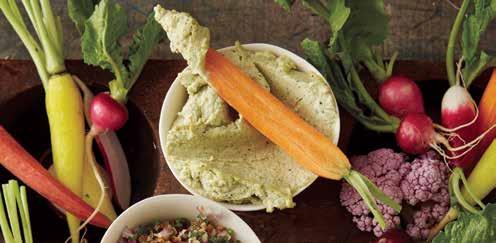
Kale Stem Hummus
Yields: 6-8 servings
1 cup dried chickpeas 1 tsp baking soda Stems from 1 bunch kale 3 garlic cloves, minced ⅔ cup tahini 1 tsp fine-grain sea salt ⅔ cup freshly squeezed lemon juice Ice water Extra-virgin olive oil for serving
The night before making the hummus, put the chickpeas in a large bowl, cover them with at least twice their volume of water and leave to soak overnight at room temperature.
The next day, drain and rinse the chickpeas. Put them, along with the baking soda, in a medium-size pot over high heat. Stir constantly for about 3 minutes.
Add 6 to 8 cups water until the chickpeas are covered by a few inches, and bring to a boil. Reduce the heat to medium, cover the pot and simmer until the chickpeas are very tender—45 to 60 minutes—checking on them occasionally to skim off any foam on the surface.
Skim off any chickpea skins that float up as well, but there’s no need to try to remove the skins if they don’t come off. They were softened by the baking soda and will blend smoothly into the hummus. Meanwhile, fill another medium-size pot with water and bring to a boil. Add the kale stems and cook until they are very tender, 30 to 45 minutes. Drain them.
Blend the kale stems, garlic and tahini in a food processor, scraping down the sides as necessary until well blended.
Once the chickpeas are cooked, drain them, add them to the kale stem mixture in the food processor along with the salt and lemon juice, and process until smooth.
Add 2 tablespoons of ice water and process until the hummus is very smooth and creamy, about 5 minutes. Add up to 2 additional tablespoons, one at a time, and process again as necessary.
To serve, spoon into a shallow bowl and drizzle with olive oil.
Note: The hummus can be stored in the refrigerator for 3 to 5 days or frozen for up to 3 months. After thawing frozen hummus, we might need to adjust the seasoning—taste and add salt and lemon juice as necessary. Also, try this hummus with other scraps like Swiss chard stalks or cauliflower cores. Follow the same cooking method as outlined, boiling until very tender, 15 to 30 minutes.
Recipe courtesy of Cooking with Scraps, by Lindsay-Jean Hard.
Find more recipes in the Conscious Eating and Recipe sections at NAChicago.com.
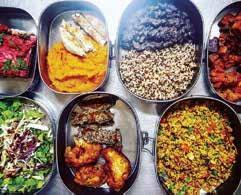
✵ We partner with GrubHub, Door Dash and Uber Eats. ✵ Weekly and monthly immunity-boosting meal plans. ✵ Family-size containers of soup, chili, brown rice, beans, stew, and more! ✵ Frozen homemade superfood patties, sprouted lentil chorizo. ✵ Health/Nutritional/Ayurvedic consultations for individualized daily regimens and recommendations to achieve optimum health.
Call to Order your Healthy Treats! 224-223-7133
341 E. Dundee Road, Wheeling Facebook.com/purplesproutcafe • www.purplesprout.com
Support Our Local Farmers! Photo by Daria Shevtsova from Pexels.jpg
SHOP CSAs, ONLINE & VIRTUAL FARMERS’ MARKETS AND CO-OPS
